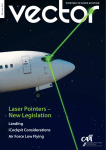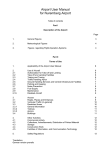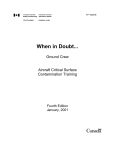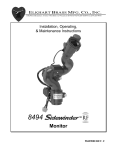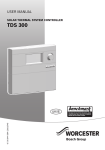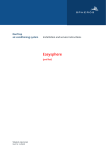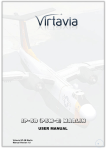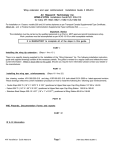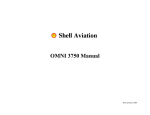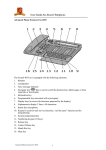Download CA AOC-AC-004
Transcript
Aircraft Ground Handling and
Servicing Advisory Circular
Subject:
AIRCRAFT GROUND HANDLING AND SERVICING: CA AOC-AC-004
Date:
18 September 2015
1. PURPOSE
This Advisory circular contains information and guidance for the servicing and ground handling of aircraft.
2. GENERAL
The aviation industry has found through experience that firm safety practices deter accidents. This advisory
circular contains generally accepted information and safety practices that may help prevent injuries to personnel
and damage to aircraft.
3. DIRECTING MOVEMENT OF AIRCRAFT
The person directing an aircraft that is being taxied should stay far enough ahead and to the left of the aircraft for
the pilot to have an unobstructed view of him.
a. Use the standard hand signals illustrated in SA CATS 91.06.13.
b. When directing aircraft during darkness or inclement weather, the signalman should use illuminated or
reflective wands.
c. Movement of aircraft in congested areas should be avoided. However, when necessary, additional
signalmen should be stationed near the aircraft wingtips to assure that adequate clearance is maintained.
4. PARKED AIRCRAFT
When an aircraft is parked, the main gear wheels should be chocked fore and aft. If the aircraft is to remain
overnight or if winds are expected, flight control locks should be used.
CA AOC-AC-004
Effective Date: 18 September 2015
Page 1 of 9
a. While turbine powered aircraft are not in service or being worked on, engine plugs should be installed to
prevent damage from dust, debris, nesting birds, etc.
b. Ground personnel should develop a habit of making a visual check of the aircraft as soon as it is parked
and secured. Before the flight crew departs, advise them of any unsafe condition that may have been
observed and determine the nature of services that will be required for the next flight. This procedure may
prevent unwarranted delays of the next departure or possible in-flight failures. Examples of conditions that
may be observed are: low or flat tires; cracked windows; nicked propeller blades; loose propeller spinners;
oil and fuel leaks; damaged flight surfaces; etc.
CAUTION: Propellers have injured many people in a moment of carelessness. When it becomes
necessary to position propellers, they should be handled as if the engine is going to start. Before moving a
propeller, always check to be sure the ignition switches are in the "off" position, and the throttle and
mixture control levers are in the "closed" position. Always stand clear of propeller blade path, particularly
when moving the propeller, because of a possible inadvertent engine start. Particular caution should be
practised around warm engines.
5. TIEDOWN OF AIRCRAFT.
Tiedown Sense. It is a good practice to always tiedown small aircraft after each flight and large aircraft when
unusually high winds are expected. When not in use, wheel chocks, tiedown ropes, or chains, and other
equipment, may be stored safely near the wing tiedown anchor points on the ramp. These are usually located
outside of the aircraft wheel traffic pattern. Wheel chocks should be painted a bright colour so they can be easily
seen.
6. TOWING OF AIRCRAFT.
When towing aircraft, the proper tow bar must be used. The wrong type of tow bar, or makeshift equipment, can
cause damage to the aircraft. Persons performing towing operations should be thoroughly familiar with the
procedures that apply to the type of aircraft to be moved. Particular care must be exercised when pulling or
pushing an aircraft with a tow vehicle.
Note: Civil Aviation Regulation 91.06.11 must be complied with.
a. One should never tow an aircraft in congested areas without signalmen to assist in determining that there
is adequate clearance.
b. No less than two people should be used to tow large aircraft, including a qualified person in the cockpit to
operate the aircraft brakes, and a qualified tow vehicle operator. One person should be able to safely
move a light aircraft with a hand operated power-towing device or tow bar provided for the aircraft.
c. The person operating the tow vehicle should assure that the nose wheel scissors or tail wheel lock is
disengaged, when applicable, before attempting to move the aircraft. The person operating the tow
vehicle should also make certain that the nose wheel swivelling limits are not exceeded during the towing
operation.
CA AOC-AC-004
Effective Date: 18 September 2015
Page 2 of 9
d. The aircraft engines should not, under normal circumstances, be operated during towing operations.
However, the procedure of pushing transport aircraft away from terminal gates, used by air transport
operators for dispatch, is an exception. If engines are operated during towing operations, procedures will
be needed to keep personnel away from rotating propellers and away from the danger zones of jet
engines.
e. Prior to movement of any aircraft, all landing gear struts and tires should be properly inflated and brake
pressure built up when applicable.
f.
The tow vehicle operator should avoid sudden starts and stops. The aircraft brakes should be applied only
in an emergency, on command from the tow vehicle operator or his signalman.
g. Clearance must be obtained from the airport control tower, either by appropriate radio frequency or by
prior arrangement through other means, before moving aircraft across runways or taxiways.
7. TAXIING OF AIRCRAFT
Only rated pilots or other qualified persons should be authorised to taxi aircraft. Persons authorised to taxi
aircraft shall be familiar with the airport control communications procedures and radio frequencies.
8. AIRCRAFT FUELLING
Improper fuelling procedures may cause aircraft accidents and in-flight incidents. If operators of fuelling
facilities establish procedures for safe and proper fuelling of aircraft and fuelling personnel follow these
procedures, many aircraft accidents or incidents will be prevented. Fuelling personnel should be familiar with
the fuel requirements for the models and types of aircraft that they are servicing. The following paragraphs
contain a description of problems that may be encountered in fuelling aircraft and recommended procedures
for combating these problems.
a. Water in the Fuel.
(1) Water occurs in aviation fuels in three forms:
(a) Dissolved water occurs similar to the humidity in the atmosphere that converts to droplets and
settles out as the fuel temperature decreases during flight.
(b) Suspended water appears in the form of droplets that reflect light. High concentration of droplets
will cause fuel to have a cloudy or hazy appearance.
(c) Solid bodies of water may be caused by leakage of storage tanks, leaking filler neck seals, or the
settling out of suspended water droplets.
(2) Accumulation of water. There is no way of preventing the accumulation of water formed through
condensation in fuel tanks. The accumulation is certain, and the rate of accumulation will vary; so it is
recommended that storage tanks, fuel truck tanks and aircraft fuel tanks be checked DAILY for the
presence of water. Any water discovered should be REMOVED immediately. In addition to the daily
water check, fuel tanks should be CHECKED AFTER EACH DELIVERY as insurance against
inadvertent water contamination.
CA AOC-AC-004
Effective Date: 18 September 2015
Page 3 of 9
(3) The minimum settling time. Adequate settling time is NECESSARY for accurate testing. The minimum
settling time for aviation gas is 15 minutes per foot-depth of fuel and 60 minutes per foot-depth of
turbine fuel.
(4) Water checks of storage tanks and fuel trucks may be made by attaching water detecting paste, or
litmus paper, to the bottom of the tank dip stick.
(a) Push the dipstick to the bottom of the tank and hold for 30 seconds. When the stick is removed,
the detecting paste or litmus paper will have changed colour if water is present.
(b) The source of excessive amounts of water must be determined and corrected before further use
of fuel from the tank.
b. Rust and scale dislodged from the inside of fuel storage tanks may enter the aircraft fuel tanks and clog
systems. Turbine fuel tends to dislodge rust and scale and carry the particles in suspension. Because of
this, fuel dispensing equipment filters should be serviced frequently. Aviation gasoline should not be
stored in tanks or equipment that have been used for turbine fuel storage.
c. Micro-organic growth thrives in turbine fuel and appears as a soapy, slippery slime on the inside surfaces
of fuel storage tanks. Micro organisms of bacteria and fungi multiply rapidly and may cause serious
corrosion in aircraft fuel tanks, as well as clog fuel filters, screens, and control units. Therefore, turbine
fuel storage tanks should be checked frequently for the presence of slime or micro-organic growth. If
found, the tank should be cleaned thoroughly to assure removal of the micro-organic growth and prevent
further contamination.
d. Dirt, lint, and dust may collect on fuel dispensing hose nozzles when proper storage receptacles are not
used. Fuel hose nozzles should not be stored in such a manner that dirt or moisture will collect in them.
Always check the nozzle for dirt and water before using it.
e. Contamination with other types or grades of fuel can cause aircraft engine damage and possible failure in
flight. Turbine fuels mixed with aviation gasoline reduce the antiknock and volatility of fuels required for
reciprocating engines. Quantities of aviation gasoline mixed with turbine fuels will cause damaging lead
deposits to collect in jet engines when used indiscriminately. Transportation or storage of turbine fuel in
tanks previously used for storage or transportation of aviation gasoline is not recommended as
contamination from rust and scale, or a possible change of fuel specification, may result.
f.
Additives. Certain turbine engine powered aircraft require the use of fuel containing anti-icing additives.
Therefore, fuel personnel must know whether or not the fuels they dispense contain additives. When antiicing additives are to be added to the fuel, the manufacturer's instructions (usually printed on the
container) should be followed to assure proper mixture. Anti-icing additive content in excess of 0.15% by
volume of fuel is not recommended as higher concentration can cause the aircraft fuel capacitance
system to give erroneous indications. Concentrations of at least 0.05% additive by volume of fuel are
effective in eliminating microbial growth.
g. Fuel Dispensing Equipment. Fuel servicing vehicles should be conspicuously and legibly marked to
indicate the type and grade of fuel.
(1) Markings should be displayed on each side and on the rear of the vehicle in CONTRASTING colours.
(2) Fuel hydrants and pit installations should be identified similarly, according to type of fuel and grade.
CA AOC-AC-004
Effective Date: 18 September 2015
Page 4 of 9
(3) Turbine fuelling vehicles should be marked to show whether or not anti-icing additives are contained in
the fuel being dispensed.
(4) Leaking or otherwise defective pumping equipment, plumbing, hoses, nozzles, and grounding cables
of fuel dispensing vehicles and stationary facilities should be repaired before further use.
Fuel/nozzle/lever stop notches should be removed to avoid the possibility of an inadvertent blocking
open of the valve.
(5) Fuel dispensing vehicles, and stationary facilities, should be equipped with appropriate fire
extinguishers, fire blankets, static grounding cables, explosion proof flashlights, and ladders. Fire
extinguishers should be located so they are accessible from either side of the vehicle and remote from
probable fire hazard.
(6) Fuelling vehicles should be positioned as distant from the aircraft as permitted by the length of the fuel
dispensing hose. Mobile units should be parked parallel to or heading away from the aircraft wing
leading edge, so it may be moved away quickly in the event of an emergency. When the fuelling
operation is completed, the fuelling vehicle should be parked at least fifty feet from aircraft or buildings
and positioned in a manner to permit removal from the area without delay.
h. Fuelling procedures. Fuelling personnel should first check with the flight crew to determine the type and
grade of fuel required, including additives for the aircraft. It is a good practice to have the pilot sign a
request for service, identifying the grade and quantity of fuel desired. In the absence of the flight crew,
fuelling personnel should check the placard located near the aircraft fuel tank filler port, or the aircraft
owner's manual that is usually carried in the aircraft, to determine the type and grade of fuel required.
(1) Check to ensure that:
(a) No electrical or radio equipment in the aircraft is energised or being maintained while fuel is being
dispensed into the aircraft, except those switches that may require energising to operate fuel
selector valves and quantity gauge systems.
(b) Qualified personnel should be stationed at the aircraft fuel control panel during pressure fuelling
operations.
(c) Fuelling personnel should not carry objects in the breast pockets of their clothing when servicing
aircraft or filling fuel service vehicles because loose objects may fall into fuel tanks.
(d) Matches or lighters should never be carried during fuelling operations.
(e) Because of the high lead content, direct fuel contact with skin or the wearing of fuel saturated
clothing should be avoided. Skin irritation or blisters may result from direct contact with fuel.
(f) Immediate medical attention should be sought if fuel enters the eyes.
(g) In the event of fuel spillage, discontinue fuelling operations until the spill can be removed, using
proper safety precautions.
(2) Fuelling from mobile equipment. The fuelling crew should follow the following sequence:
(a) Connect a grounding cable from the fuelling vehicle to a satisfactory ground. Grounding posts
usually consist of pipes or rods driven far enough into the ground to result in a zero potential.
(b) Connect a ground cable from ground to the aircraft (on landing gear axle or other unpainted
surface). Do not attach ground cables to the propeller or radio antenna.
(c) Connect a grounding cable from the fuelling vehicle to the aircraft. The fuelling vehicle may be
equipped with a "T" or "Y" cable permitting ground attachment first and grounding of the aircraft
with the other end.
CA AOC-AC-004
Effective Date: 18 September 2015
Page 5 of 9
(d) Connect a grounding cable from the fuel nozzle to the aircraft before removing the aircraft tank
cap. This bond is most essential and needs to be maintained throughout the fuelling operation and
until the fuel cap is replaced.
CAUTION: Conductive-type fuel hose does not provide a satisfactory method of bonding.
(e) The fuel dispensing equipment-grounding cables should be removed in the reverse order of the
sequence outlined above.
(3) Fuelling from hydrants, pits, and cabinets.
(a) Connect the grounding cable from the dispenser to the aircraft.
(b) Connect the grounding cable from the hose nozzle to the aircraft before removing the fuel cap.
(4) Overwing fuelling. The fuel filler hose should be draped over the wing leading edge. Never lay the fuel
filler hose over the wing trailing edge because aircraft structural damage may result. A simple rubber
shower mat may be used to provide protection for wing leading edges during fuel operation.
Stepladders or padded upright ladders may be used to provide easy access to high wing and large
aircraft. Standing on wing surfaces should be avoided and never stand on wing struts. Hold the fuel
nozzle firmly while it is inserted in the fuel tank filler neck and never block the nozzle lever in the open
position. Be sure that fuel filler caps are replaced and securely latched when fuelling is completed.
(5) Underwing fuelling. Discharge possible static build-up in the fuel dispensing hose by touching the
pressure nozzle to an unpainted part of the aircraft, such as a landing gear axle, before attaching to
the aircraft filler receptacle. No static ground wire between the filler nozzle and the aircraft is
necessary.
(6) The aircraft fuel tank sumps should be drained before each fuel servicing to remove water that may
have accumulated from condensation or entered the tank during fuelling operations. Draining fuel
sumps immediately after fuelling serves little purpose because the agitation action of fuel entering the
tank may suspend water and contaminants - which can remain suspended for many minutes and may
not settle out until the aircraft is airborne.
i. Safety precautions
Safety precautions must be always taken to preclude the possibility of fire during refuelling and defuelling
procedures.
The main causes of risk of fire with fuel deal with:
- spark due to static electricity
- hot point (engines, APU, ground installations, smoking).
The fuel generally does not catch fire easily, but the risk of fire is increased when the fuel is sprayed (link,
disconnecting pipe) and in the presence of fuel vapour specially when low flash point fuels are used.
General safety precautions for fuelling procedures and the list of approved fuel types and additives are given
in Aircraft Maintenance Manual (AMM) - servicing chapter.
CA AOC-AC-004
Effective Date: 18 September 2015
Page 6 of 9
Therefore, the following precautions apply during any fuelling operations:
. engine ignition system must be "OFF".
. the weather radar must be switched OFF
. radio are not transmitting on HF.
. electrical circuits in the tanks area must not been connected or disconnected
. no open flame, smoking is permitted around the aircraft
For aircraft fitted with a trim tank, refuel or defuel procedure should ensure that there is no fuel in the trim tank
as long as the wing tanks are not full and that wing tanks are not defuelled as long as trim tank is not empty in
order to avoid a possible tail tipping.
j. Refuelling with one engine running
Procedure for refuelling with one engine running is given in FCOM "LOADING" chapter.
This procedure may be used only if:
- no external ground pneumatic is available while APU is unserviceable.
- airport authorisation is obtained for this operation.
- airport fire department stands by at the aircraft during the entire refuelling procedure.
- one flight crew member can manage the operation and monitor all systems and the engine running from the
cockpit.
- a qualified ground crew member is present at the fuelling station.
- the refuelling system is fully operational (overwing filling is not permitted).
k. Refuelling and defuelling (fuelling) when passengers are embarking, on board or disembarking
Fuelling is not permitted with passengers boarding, on board or disembarking with wide cut gasoline type fuel (Jet
B, JP4, JP8 or equivalent) or when a mixture with these types of fuel might occur.
Fuelling with Jet A or Jet A1, when passengers are embarking, on board, or disembarking is allowed. However,
when passengers are involved, precautions must be taken to ensure that they can be evacuated in the unlikely
event that fire does occur. These precautions involve the ramp agent, the engineer (qualified ground crew
member), the cabin crew and the pilot(s).
The ramp agent must ensure that, pilot(s), cabin crew and engineer are at their stations that the area around
emergency exits is kept clear, that the fire service is alerted and that passenger boarding / disembarkation is
carried out in a controlled manner.
The pilot(s) must establish communication with the engineer, inform the cabin crew of the beginning
and ending of fuelling, listen for fire warning from the engineer and be prepared to initiate passenger
evacuation if necessary.
The engineer must establish communications with the pilot(s), inform the pilot(s) of the beginning and ending of
fuelling, and alert Pilot(s) if fire occurs. He must stop fuelling upon pilot request.
The cabin crew must establish communication with the pilots, warn passengers not to smoke ("no smoking" sign
must be "ON"), instruct them to unfasten their seat belts ("Fasten seat belt" sign must be "OFF"), ensure that
CA AOC-AC-004
Effective Date: 18 September 2015
Page 7 of 9
emergency exits are unobstructed and that "EXIT" sign is "ON" and that ground servicing such as catering or
cleaning don't risk creating hazard or hindering an emergency evacuation .
If presence of fuel vapour is detected inside the airplane or any other hazard arises, re/defuelling must be stopped
immediately.
l. Precautions with mixed fuels
More stringent precautions must be observed when refuelling an aircraft with JET B or JP4 fuel where the fuel
tanks already contain JET B or JP4 or a mixture of JET B / JP4 and JET A or JET A1.
JET A and JET A1 are kerosene type fuel.
JET B and JP4 are wide cut gasoline type fuel with a low flash point, which are not widely used. JET B can be
found in Canada and Scandinavian countries. JP4 is used in military aviation, but is being replaced by JP8
(kerosene type fuel) which provide more safety.
A major consideration when mixing fuels at normal temperatures is the fuel air mixture that develops in the space
above the fuel inside the tank. JP4 and JET B develop an ignitable fuel air mixture at frequently encountered
ambient temperatures and when JP4 or JET B and JET A1 are being mixed, the fuel vapour mixture with air is in
the explosive or ignitable envelope throughout the range of ground temperatures common at the majority of
airports during all or part of the year.
Overwing refuelling is not permitted when loading JET B or JP4 into an aircraft with JET A1 or other kerosene type
already on board and vice versa.
9. SERVICING OF OXYGEN SYSTEMS.
Certain precautions should be observed whenever aircraft oxygen systems are to be serviced.
a. Before servicing any aircraft with oxygen, consult the specific aircraft service manual to determine the type
of equipment required and procedures to be used.
b. Oxygen system servicing should be accomplished only when the aircraft is located outside of hangars.
c. Personal cleanliness and good housekeeping are imperative when working with oxygen. Oxygen under
pressure and petroleum products creates spontaneous results when they are brought in contact with each
other. Service people should be certain to wash oil and grease (including lip salves, hair oil, etc.), and dirt
from their hands before working around oxygen equipment. It is also essential that clothing and tools are
free of oil, grease, and dirt.
d. Aircraft with permanently installed oxygen tanks usually require two persons to accomplish servicing of the
system. One man should be stationed at the service equipment control valves, and the other stationed
where he can observe the aircraft system pressure gauges.
e. Oxygen system servicing is not recommended during aircraft fuelling operations or while other work is
performed that could provide a source of ignition.
f.
Oxygen system servicing while passengers are on board the aircraft is not recommended.
CA AOC-AC-004
Effective Date: 18 September 2015
Page 8 of 9
REVIEWED & VALIDATED BY:
SIGNATURE OF
SENIOR MANAGER: FOD
NAME IN BLOCK LETTERS
DATE
NAME IN BLOCK LETTERS
DATE
APPROVED BY:
SIGNATURE OF
EXECUTIVE MANAGER: ASO
END
CA AOC-AC-004
Effective Date: 18 September 2015
Page 9 of 9










